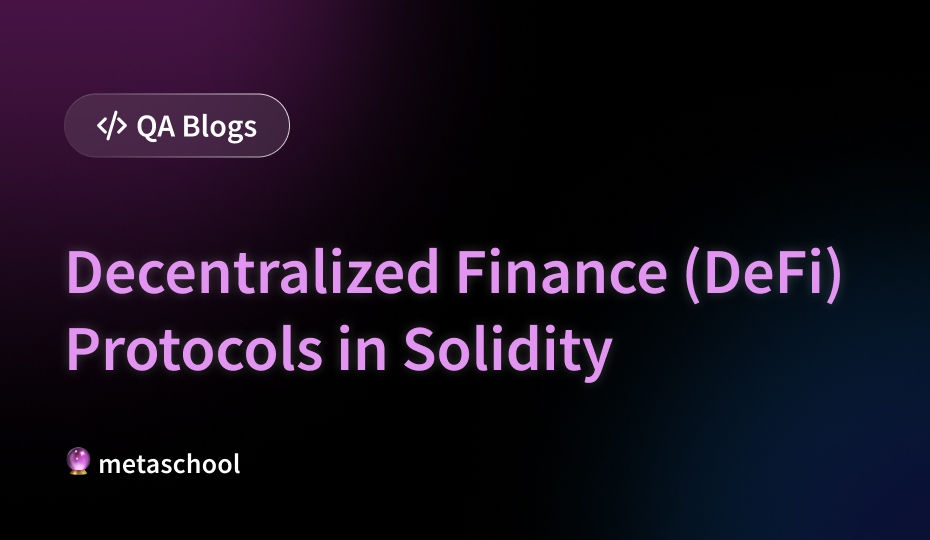Table of Contents
Decentralized Finance (DeFi) has emerged as one of the most exciting and transformative applications of blockchain technology, enabling permissionless access to financial services and products without the need for traditional intermediaries. At the heart of many DeFi applications are smart contracts written in Solidity, the programming language for the Ethereum blockchain. In this article, we’ll delve into the world of DeFi protocols implemented in Solidity, exploring their functionalities, architecture, and impact on the financial landscape.
Understanding DeFi Protocols
DeFi protocols are decentralized applications (DApps) that replicate and innovate upon traditional financial services using blockchain technology. These protocols facilitate peer-to-peer lending, borrowing, trading, asset management, and other financial activities without relying on centralized institutions such as banks or exchanges. DeFi protocols typically consist of a set of smart contracts deployed on the blockchain, which govern the rules and interactions of the protocol.
Popular DeFi Protocols Implemented in Solidity
1. Decentralized Exchanges (DEXs)
Decentralized exchanges allow users to trade cryptocurrencies and tokens directly with each other without the need for intermediaries. Protocols like Uniswap, SushiSwap, and Balancer are implemented in Solidity and enable automated market-making, liquidity provision, and decentralized trading using liquidity pools and automated pricing algorithms.
2. Lending and Borrowing Platforms
Lending and borrowing platforms enable users to lend out their assets to earn interest or borrow assets by providing collateral. Protocols like Compound, Aave, and MakerDAO offer decentralized lending and borrowing services, allowing users to access liquidity and earn yields on their idle assets through algorithmic interest rates and collateralized loans.
3. Automated Market Makers (AMMs)
Automated market makers are protocols that enable decentralized token swaps and liquidity provision using liquidity pools. Protocols like Uniswap and Curve Finance utilize constant product market-making algorithms implemented in Solidity smart contracts to facilitate efficient and permissionless token trading with low slippage and high liquidity.
4. Yield Farming and Liquidity Mining
Yield farming and liquidity mining protocols incentivize users to provide liquidity to DeFi platforms by rewarding them with native tokens or rewards. Protocols like Yearn.Finance, Compound, and SushiSwap offer yield farming opportunities through liquidity mining incentives, staking, and yield optimization strategies implemented in Solidity smart contracts.
Architecture of DeFi Protocols in Solidity
DeFi protocols implemented in Solidity typically consist of several key components:
- Smart Contracts: Smart contracts written in Solidity define the rules, logic, and operations of the protocol, including token standards, governance mechanisms, and financial primitives such as lending pools, liquidity pools, or automated market-making algorithms.
- User Interfaces (UIs): User interfaces interact with the smart contracts to enable users to interact with the protocol through web or mobile applications. UIs provide functionalities such as token swaps, lending and borrowing, liquidity provision, and yield farming.
- Oracles: Oracles provide external data feeds to DeFi protocols, such as price oracles for decentralized exchanges or interest rate oracles for lending platforms. Oracles fetch and aggregate data from external sources and relay them to the smart contracts to enable real-time data-driven operations.
- Governance Mechanisms: Some DeFi protocols incorporate governance mechanisms that allow token holders to participate in decision-making processes such as protocol upgrades, parameter adjustments, or allocation of protocol fees. Governance tokens are used to stake and vote on governance proposals through smart contracts.
Challenges and Considerations
While DeFi protocols offer exciting opportunities for innovation and financial inclusion, they also face several challenges and considerations:
- Security: DeFi protocols must prioritize security to protect against smart contract vulnerabilities, hacks, and exploits. Secure coding practices, formal verification, and regular audits are essential to mitigate security risks.
- Scalability: Scalability remains a challenge for DeFi protocols, particularly during periods of high network congestion and gas fees on the Ethereum blockchain. Layer 2 solutions, sidechains, and interoperability protocols are being explored to address scalability limitations.
- Regulatory Compliance: DeFi protocols must navigate regulatory uncertainty and compliance requirements, particularly regarding know-your-customer (KYC) and anti-money laundering (AML) regulations. Regulatory clarity and compliance solutions are crucial for the long-term viability and adoption of DeFi.
- User Experience: Improving the user experience of DeFi protocols, including onboarding, transaction speed, and cost, is essential to drive mainstream adoption and usability. User-friendly interfaces, gas optimizations, and educational resources are key to enhancing the user experience.
Conclusion
DeFi protocols implemented in Solidity represent a revolutionary paradigm shift in the financial industry, enabling decentralized, transparent, and permissionless access to financial services and products. From decentralized exchanges and lending platforms to automated market makers and yield farming protocols, DeFi offers a diverse array of opportunities for innovation and financial empowerment. As the DeFi ecosystem continues to evolve and mature, it holds the potential to democratize finance, disrupt traditional banking systems, and empower individuals worldwide to take control of their financial destinies.
